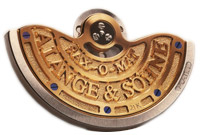GeekTime! Watch Movements Explained




 (No Ratings Yet)
(No Ratings Yet)Upgrade Your Man Cave for Father's Day
 One of the things I enjoy the most about writing the CrazySales blog is the ability to write about anything that interests me. I was browsing Crazysales.com today and realized that we actually have some really great watches, which thrilled me, because I've been experiencing a growing obsession lately with all things watch-related. I've actually been in the market for a new timepiece myself. But before I make the purchase I decided to do a little homework and educate myself on the various types of watch movements that are out there. There are many types of watch movements, but I'm just going to give a very simple description of the 3 most common types of movements that you will likely choose from when purchasing your next watch.
One of the things I enjoy the most about writing the CrazySales blog is the ability to write about anything that interests me. I was browsing Crazysales.com today and realized that we actually have some really great watches, which thrilled me, because I've been experiencing a growing obsession lately with all things watch-related. I've actually been in the market for a new timepiece myself. But before I make the purchase I decided to do a little homework and educate myself on the various types of watch movements that are out there. There are many types of watch movements, but I'm just going to give a very simple description of the 3 most common types of movements that you will likely choose from when purchasing your next watch.
Quartz
Electrical watches, or more commonly known as Quartz watches, are probably the most widely purchased among low to mid range watches. They are electrical, not mechanical, which means they are extremely easy to produce in bulk, and that low cost also carries over to your wallet when it's time to purchase. But don't be mistaken, just because quartz watches are cheaper to purchase, they are not cheap in their ability to keep the time. Quartz watches are by far the most accurate of any watch movement. A typical quartz movement is accurate to +/- 15 seconds every 30 days. In timekeeping, that's pretty darn good. In addition to being extremely accurate, there is virtually no upkeep besides changing out the battery every few years.
Mechanical
Mechanical watch movements are the oldest and original type of watch movement. These require you to manually turn the crown, which winds the mainspring, giving power to the watch. Of course the spring has to be regulated, otherwise when you release the crown, the watch hands would just turn wildly out of control. The mainspring is regulated by something called the escapement — this is what gives the ticking sound that you hear. On some watches, you can actually see and hear the escapement moving back and forth, tick, tick, tick, releasing the power from the mainspring into the gears which turn the hands. The accuracy of mechanical watches is going to vary depending on the precision of the movement as well as the precision of the watchmaker.
Automatic
 Automatic watches are also a type of mechanical watch, with one key difference. In a regular mechanical watch, you must wind the crown to give power to the movement. In an automatic watch there is the addition of a rotor, or an internal swinging pendulum (pictured) which turns by itself using the natural movements of your arm. As the pendulum turns, it sends power to the mainspring through a set of winding gears. Like mechanical watches, there will be a lot of variation in pricing depending on the precision put into the making of the watch. There are other factors as well, such as the power reserve, or how long your watch will accurately keep the time when you've taken it off your wrist, etc.
Automatic watches are also a type of mechanical watch, with one key difference. In a regular mechanical watch, you must wind the crown to give power to the movement. In an automatic watch there is the addition of a rotor, or an internal swinging pendulum (pictured) which turns by itself using the natural movements of your arm. As the pendulum turns, it sends power to the mainspring through a set of winding gears. Like mechanical watches, there will be a lot of variation in pricing depending on the precision put into the making of the watch. There are other factors as well, such as the power reserve, or how long your watch will accurately keep the time when you've taken it off your wrist, etc.
Of course all of the different technical additions such as date, chronograph, and even an altimeter, can effect the price. Take your time and choose the best watch according to how you plan to use it. And if you want a visual explaination of the movements I've just described, check out this video below:
Watch movements can get extremely involved, including function called a tourbillon.
-
-
 Genki VS Powerfit : Whole Body Vibration Machine Buying Guides
9 years ago
Genki VS Powerfit : Whole Body Vibration Machine Buying Guides
9 years ago
-
 How Do Air Fryers Work? Maxkon Airfryer VS Philips Air Fryer Reviews
9 years ago
How Do Air Fryers Work? Maxkon Airfryer VS Philips Air Fryer Reviews
9 years ago
-
 Genki Exercise Bike VS Lifespan Treadmill: Gym Equipment Buyer’s Guide
9 years ago
Genki Exercise Bike VS Lifespan Treadmill: Gym Equipment Buyer’s Guide
9 years ago
-
 Easy and Healthy Blender Recipe Top 6
10 years ago
Easy and Healthy Blender Recipe Top 6
10 years ago
-
 Top 10 Popular Easter Bonnet Ideas | How to DIY Easter Hats for Bonnet Parades
3 years ago
Top 10 Popular Easter Bonnet Ideas | How to DIY Easter Hats for Bonnet Parades
3 years ago
-
 Top Five Handy Pick-ups to Fulfill Your Home Gym
9 years ago
Top Five Handy Pick-ups to Fulfill Your Home Gym
9 years ago
-
 Best Cooling Fan Reviews Maxkon VS Dyson 2021 | Turn Your Home Into A Summery Oasis
4 years ago
Best Cooling Fan Reviews Maxkon VS Dyson 2021 | Turn Your Home Into A Summery Oasis
4 years ago
-
 Which Do You Prefer to Stay Cool with This Summer: a Fan, an Air Conditioner or an Ice Maker?
8 years ago
Which Do You Prefer to Stay Cool with This Summer: a Fan, an Air Conditioner or an Ice Maker?
8 years ago
-
 Winter Checklist: Electric Blanket, Comforter and Heated Towel Rail To Help You Through Australian Winter
9 years ago
Winter Checklist: Electric Blanket, Comforter and Heated Towel Rail To Help You Through Australian Winter
9 years ago
-
 Keep Food Always Fresh: Maxkon VS Sunbeam Vacuum Sealer Review Australia
9 years ago
Keep Food Always Fresh: Maxkon VS Sunbeam Vacuum Sealer Review Australia
9 years ago
-



